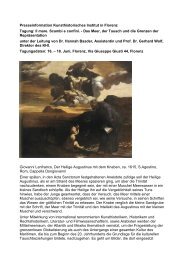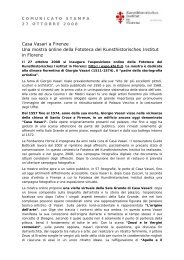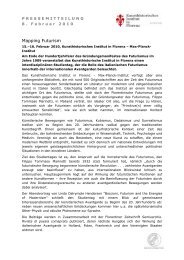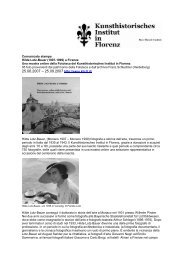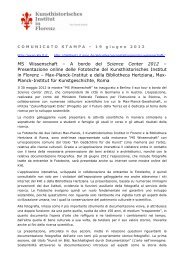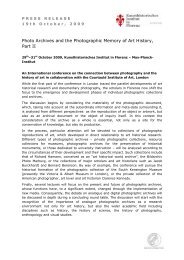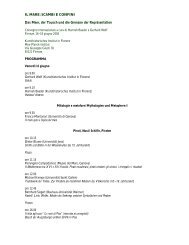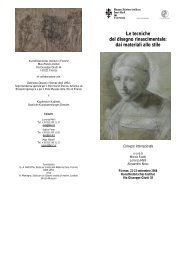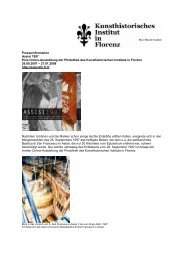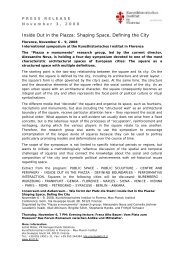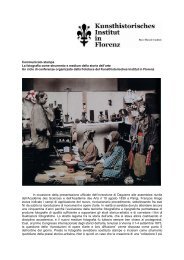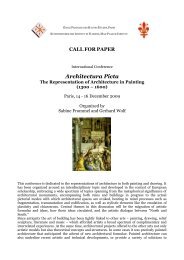Statusbericht - Homepage - Kunsthistorisches Institut in Florenz
Statusbericht - Homepage - Kunsthistorisches Institut in Florenz
Statusbericht - Homepage - Kunsthistorisches Institut in Florenz
Erfolgreiche ePaper selbst erstellen
Machen Sie aus Ihren PDF Publikationen ein blätterbares Flipbook mit unserer einzigartigen Google optimierten e-Paper Software.
who characterized the artistic community of Bellosguardo as „Europeans of the future“<br />
(Europäer von Übermorgen). The dissertation reconstructs the social and <strong>in</strong>tellectual<br />
<strong>in</strong>teraction of the artistic circle by focus<strong>in</strong>g primarily on the English and German artists<br />
– Stanhope, Evelyn De Morgan, Stillman, Hildebrand, Marées, and Böckl<strong>in</strong>.<br />
The engagement of Italian artists with their own medieval and early Renaissance past<br />
was also an important force <strong>in</strong> the creative life of Bellosguardo. Italy had only recently<br />
been unified and the active <strong>in</strong>terpretation of its artistic heritage played an important role<br />
<strong>in</strong> the formation of its new national identity. Early Italian art was seen as offer<strong>in</strong>g<br />
someth<strong>in</strong>g especially vital to the present. Pa<strong>in</strong>ters such as Giovanni Costa and Giuseppe<br />
Catani Chiti, who were associated with English artists at Bellosguardo, saw <strong>in</strong> fifteenthcentury<br />
Florent<strong>in</strong>e pa<strong>in</strong>t<strong>in</strong>g the basis of a true Italian art, purged of <strong>in</strong>stitutionalized and<br />
formulaic realism, on the one hand, and the foreign <strong>in</strong>fluence of Impressionism on the<br />
other. S<strong>in</strong>ce accounts of this period have tended to represent the Italians as passive<br />
observers rather than active participants <strong>in</strong> the work be<strong>in</strong>g done around them, their<br />
contribution is important to emphasize.<br />
Reasons for the neglect of the Bellosguardo circle are not far to seek. The study of<br />
n<strong>in</strong>eteenth-century and early twentieth-century modernism has been dom<strong>in</strong>ated by<br />
assumptions which tend to foreground French art and especially the radically new formal<br />
language that culm<strong>in</strong>ated <strong>in</strong> abstraction. These assumptions have been questioned <strong>in</strong><br />
recent years, by British scholars work<strong>in</strong>g on British art, who have po<strong>in</strong>ted out that<br />
French developments should not be regarded as normative: they have made the case<br />
that movements such as Pre-Raphaelitism and the Gothic Revival are symptomatic of<br />
modernism even though they are radically backward-look<strong>in</strong>g. Useful as it has been,<br />
this scholarship is limited by its tendency to re<strong>in</strong>force a nationalistic orientation and to<br />
encourage a similar treatment of other national traditions. Such an approach overlooks<br />
the vitality and importance of <strong>in</strong>ternationalism as a motivat<strong>in</strong>g force and a pervasive<br />
factor <strong>in</strong> the development of modern art. A study of the English and German artists<br />
of Bellosguardo and of the way <strong>in</strong> which they respond and contribute to the<br />
development of an <strong>in</strong>ternational modernism <strong>in</strong> Florence, can thus contribute to our<br />
understand<strong>in</strong>g of modernism as a whole.<br />
55<br />
Forschungen des wissenschaftlichen Nachwuchses



